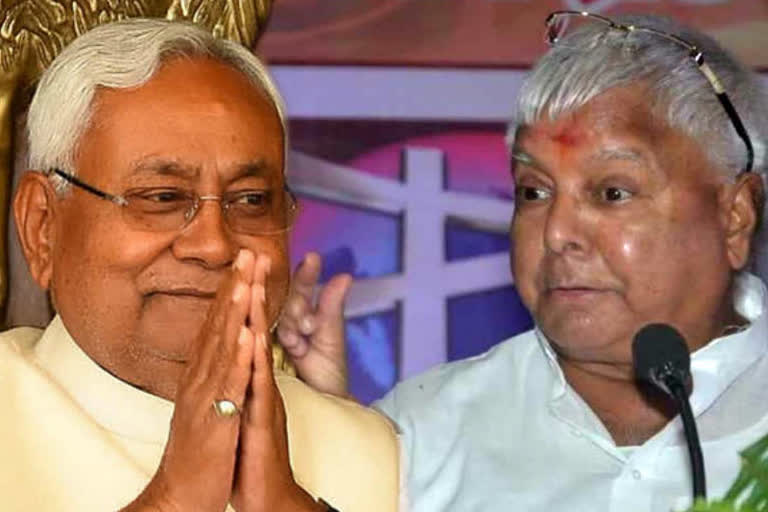Patna: With the elections in Bihar round the corner, talks about development have automatically started gaining momentum. The ruling Nitish government in Bihar is comparing its work in the last 15 years with the 15 years of the preceding governments.
Though the Nitish government, which has been in power for 15 years, is comparing its functioning with that of Lalu Yadav's, the crucial topic of industrialisation could never become an electoral issue in the state. As a result, industrialisation in Bihar could never catch the pace.
A look at the 15-year-rule of Nitish Kumar reveals that work was done in the field of manufacturing, but the situation of industrial disparity in the state could not be overcome.
Big reason for migration
For the past 30 years, Jayaprakash Narayan's disciples have been at the helm of power in Bihar. From 1990 to 2005, Lalu Yadav took the reins of power, while Nitish Kumar was in power from 2005 to 2020.
Pertinently, industrialisation could not be accelerated during this 30-year rule in the state. As a result, 50 lakh people from Bihar migrated for livelihood to other states.
However, a series of claims, counter-claims, and allegations have once again started about industrial development before the Bihar Assembly elections. While the JDU claims that efforts were made to give impetus to industries during Nitish Kumar's reign, the RJD has stressed that it established several factories during the rule of Lalu Yadav.
Read: Mahagathbandhan prioritising alliance with Left parties for Bihar polls
A look at the net state gross domestic product:
- 1991-92 - 13.49%
- 2004-05 - 12.82%
- 2009-10 - 18.39%
Primary sector, secondary and tertiary sector come under the gross state value addition. Gross state value addition in the primary sector was 21.3 per cent during 2017-18, 19.7 per cent in the secondary sector and 59 per cent in the tertiary sector.
When we talk about manufacturing in the secondary sector, it was 9.5 per cent and production was 8.23 per cent. It decreased to 19.1 per cent in 2018-19. During the last four years, the growth rate in electricity, gas and water supply was 1.5 per cent.
The construction sector was 10.2 per cent in 2012, which has come down to 9.5 per cent in 2018-19.
Demonetization and GST also greatly affected the industries in Bihar. Manufacturing was 1.3 per cent in 2017-18, 3 per cent in 2018-19 and 25 per cent in 2016-17.
Read: Nitish Kumar should speak on crime, unemployment in Bihar: Tejashwi Yadav
The industrial growth rate between 2004 and 2009 was 5.8 per cent, which has reached double-digit till date. If we consider per capita income, then in 2004-2005 the annual figure was 7, 914.
So at the same time, the annual per capita income of Bihar increased to 26, 693 in 2017-18.
These figures of per capita income are limited to a few cities in Bihar. There are 15 districts of Bihar, whose per capita income is below 10,000 and there are 35 districts where the per capita income is less than 15,000.
There is a large disparity in the state in terms of per capita income.
Growth rate in the area of construction
In 1991, the growth rate in the construction sector was 6.24 per cent, which increased to 17.3 per cent in 2010-11 and the figure decreased to 9.4 per cent in 2019-20. The growth rate in electricity, water and gas was 5.91 per cent in 1990-91 to 2.81 per cent in 2010-11 and to 5.3 per cent in 2018-19.
Read: BJP using SSR death case for Bihar polls, says Congress
Election response to claims
It is the election season and we are now witnessing a round of claims. RJD leader and former minister Alok Mehta has said that the single window system could not be implemented due to bureaucracy and red-tapism in Nitish Kumar's reign. As a result, hundreds of businessmen returned.
As far as industrialization is concerned, Lalu Yadav was the Union railway minister, and it was during that time that many big factories were set up in Bihar. This gave employment to thousands of people, giving speed to industrialization, Mehta said.
Speaking to ETV Bharat, the present Industries Minister of Bihar Maheshwar Hazari said, "I agree that there were no big industries in Bihar. But on a small scale, the number of industries started in Bihar. They are a record at the national level. We are making efforts for industrialization in Bihar at a rapid pace."
But poverty has still not reduced
Economist DM Diwakar believes that industrialization should have taken place in Bihar, which, unfortunately, has not been done.
The net domestic product per capita was 32.5 per cent of India's net domestic product in 2004-05, and the figure was the same at around 32.5% in 2017-18 as well. This means that Bihar's share in the country's income did not increase.
"We only maintained the status quo. The growth rate in the construction and service sectors in Bihar has increased. People's income has also increased but overall poverty has not reduced," he said.
Read: Bihar polls: Will Congress be left behind, or revive?
However, this time around as the elections approach, industrialization seems to be becoming a big issue. The reason behind this is the return of nearly three million migrant labourers and their vote bank.
All pre-election talk is being centred around of providing employment.
However, without setting up industries, it is impossible to generate jobs. If there was a large scale of employment through government schemes, the mass migration might become a thing of the past.
Every day, people from many districts of Bihar are seen at railway stations and bus stops. A similar view is seen at the airport, with a few migrant labourers leaving Bihar after getting tickets at the mercy of their bosses.



